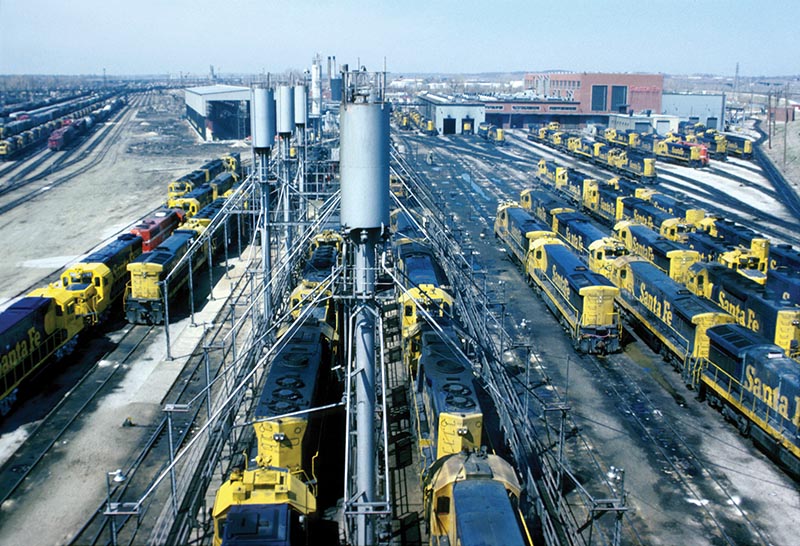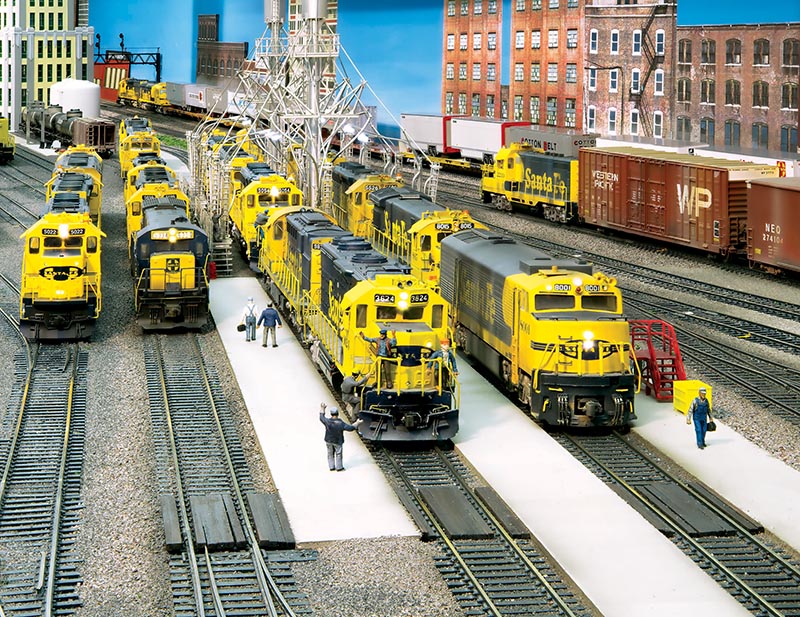 By Stephen M. Priest
By Stephen M. Priest
Locomotives, their servicing facilities, and the hundreds of employees there represent a major investment for railroads. If maintained and available, motive power provides a positive revenue source, and the prototype spends a significant portion of its budget on locomotives. I operated trains on the real Santa Fe out of Argentine, Kansas, for nearly a decade, and I loved the locomotive facilities located there. We would often pick up our locomotive consist on the ready tracks and head out the west end to tie onto our waiting train. Because of its accessibility from public land, many photographs of the Argentine Shops and sanding towers exist, making it possible to reproduce the facility or a reasonable facsimile of it.

Part of my strong interest in modeling a large facility was the impression that Argentine (Kansas City) made on me as a youth. Even on a slow day, you could see at least 100 units being serviced, painted, and rebuilt. It is a scene that I will never forget. Kevin EuDaly photo
I decided early on that I wanted a major locomotive facility to showcase my motive power while modeling the practices of the prototype. The care and servicing of locomotives is very interesting and fun to replicate. Our model of the locomotive facility is divided into two areas, each with a different purpose. The LMIT or Locomotive Maintenance and Inspection Terminal acts as a heavy shop. Engine rebuilds, power pack change-outs, repainting, traction motor change-out, and heavy work is performed there. An open-sided locomotive shop building was planned so that visitors and operators could see inside the shop. Several storage tracks for damaged or LUBO (Laid Up Bad Order) locomotives were provided next to the shop building. A transfer table just outside the main shop building allows quick placement of motive power to its correct bay in the shop.
 General Electric made only six U30CGs, and all of them went to the Santa Fe. Initially ordered for passenger service and adorned in red and silver, all that changed in the early 1970s when they were reassigned to freight service with the coming of Amtrak. Here, 8001 pulls through the wash rack at Argentine for a cleaning. Dan Munson photo
General Electric made only six U30CGs, and all of them went to the Santa Fe. Initially ordered for passenger service and adorned in red and silver, all that changed in the early 1970s when they were reassigned to freight service with the coming of Amtrak. Here, 8001 pulls through the wash rack at Argentine for a cleaning. Dan Munson photo
The other half of the facility is referred to as the DSF or Diesel Service Facility. Here, the in-service “active” fleet of locomotives receives fuel, sand, FRA-required inspections, quick filter change-outs, and cleaning. St. Louis Division operator and friend Stephen Hottle found two Overland Models sanding towers on eBay, purchased them, and donated them to the layout project. We rebuilt the towers, adding LED lighting and additional piping, and then painted them in a dull silver to match similar prototypes found in Argentine. Sidewalks were made from Sintra and glued in place. The towers were set into place and then wired into the layout. The entire area was ballasted and is set to be heavily weathered as per the prototype. The facility provides the visitor and the operators with a stunning motive power experience.

Aside from wanting a facility to “service” the locomotives, break down and build consists, locomotive facilities are a great place to showcase your motive power fleet. Get your locomotives off the shelves and onto the layout where they belong! Dan Munson photo
This article appeared in the April 2019 issue of Railroad Model Craftsman! Subscribe Today!



